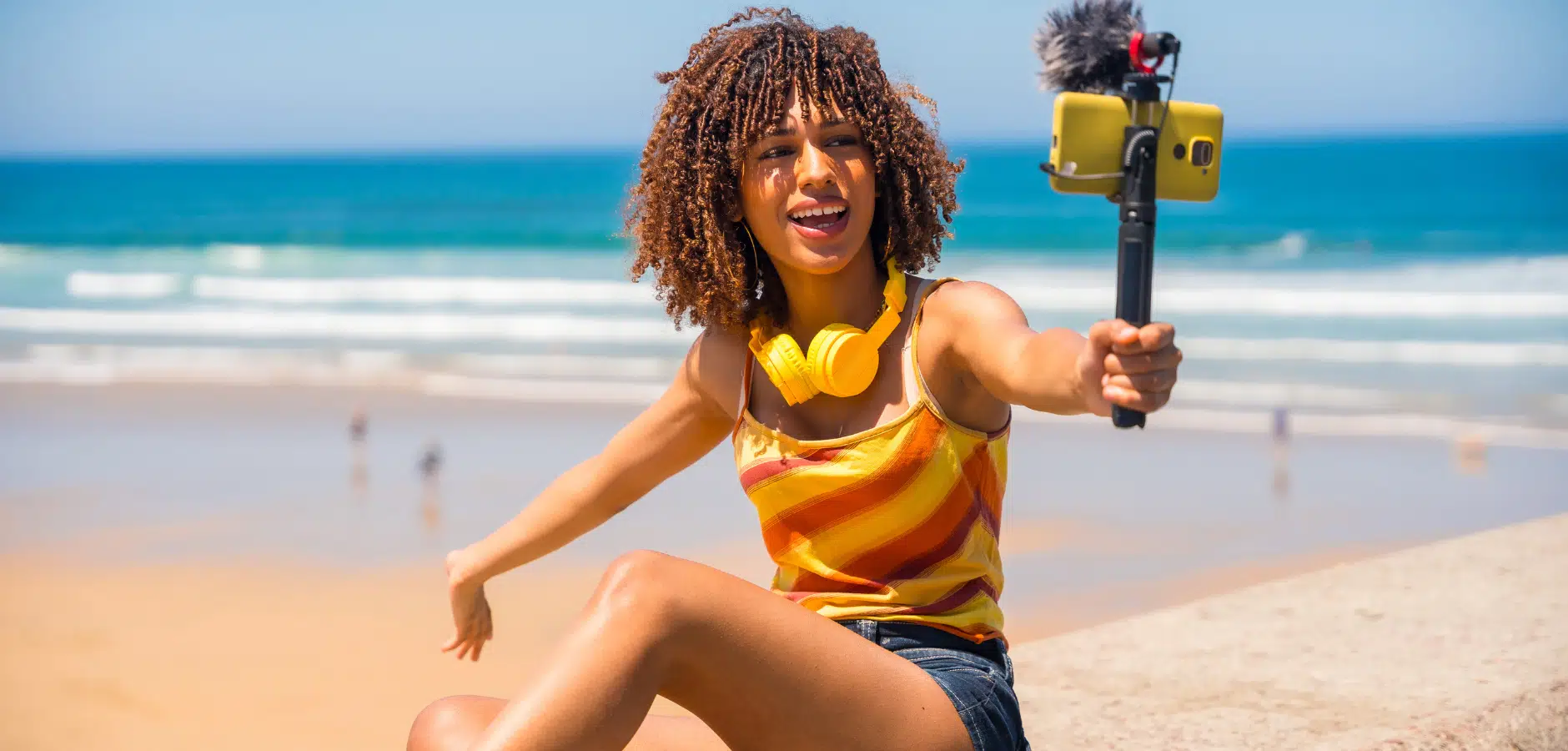Are you paying YouTube creators flat fees with no way to track sales? You’re not alone—and you’re leaving money on the table.
YouTube’s 2.5 billion users represent a massive opportunity, but only if you shift from transactional campaigns to performance-based partnerships. The brands winning in 2026 use hybrid compensation, social commerce integration, and AI-powered creator discovery to turn views into revenue.
Here’s your roadmap:
- Three pillars for high-performing YouTube partnerships
- Compensation models that align creator incentives with your return on investment (ROI)
- Measurement frameworks that connect content to customers
The new competitive advantage in YouTube partnerships
Your YouTube influencer program is probably driving ROI. The question is: how does it compare to what’s actually possible?
Consider what brands are achieving with strategic YouTube partnerships:
- Ambari Nutrition: 300 percent revenue increase for a targeted product line, 40 percent higher conversion rate than average traffic
- Electcomm Group Electrical & Data: 18% conversion rate—nearly 3x their performance on other platforms
- Get Me Links client: 47 percent increase in referral traffic, doubled organic conversions within 90 days
- Hello Electrical: 28 percent lead growth in six weeks, cost per lead (CPL) dropped from $42 to $30
The difference between these results and the average performance? Operational sophistication.
These brands share three structural advantages:
- Audience-first discovery (not follower-count-first)
- Performance-dominant compensation (not flat fees with performance sprinkles)
- Systematic optimization (not quarterly check-ins)
| Element | Top-performer approach |
| Discovery | Audience-data driven selection (demographics, content themes, engagement quality) over vanity metrics |
| Compensation | Performance-dominant structure—60 percent of creator earnings tied to conversions |
| Content | Multi-video series with creator autonomy, not one-off scripted spots |
| Duration | 6-12 months partnerships that allow creators to become genuine advocates |
| Measurement | Real-time dashboards tracking customer acquisition cost (CAC), return on ad spend (ROAS), and customer lifetime value (LTV)—not post-campaign reports |
| Optimization | Continuous testing and scaling of top performers |
This guide outlines the steps for implementing each of these elements.
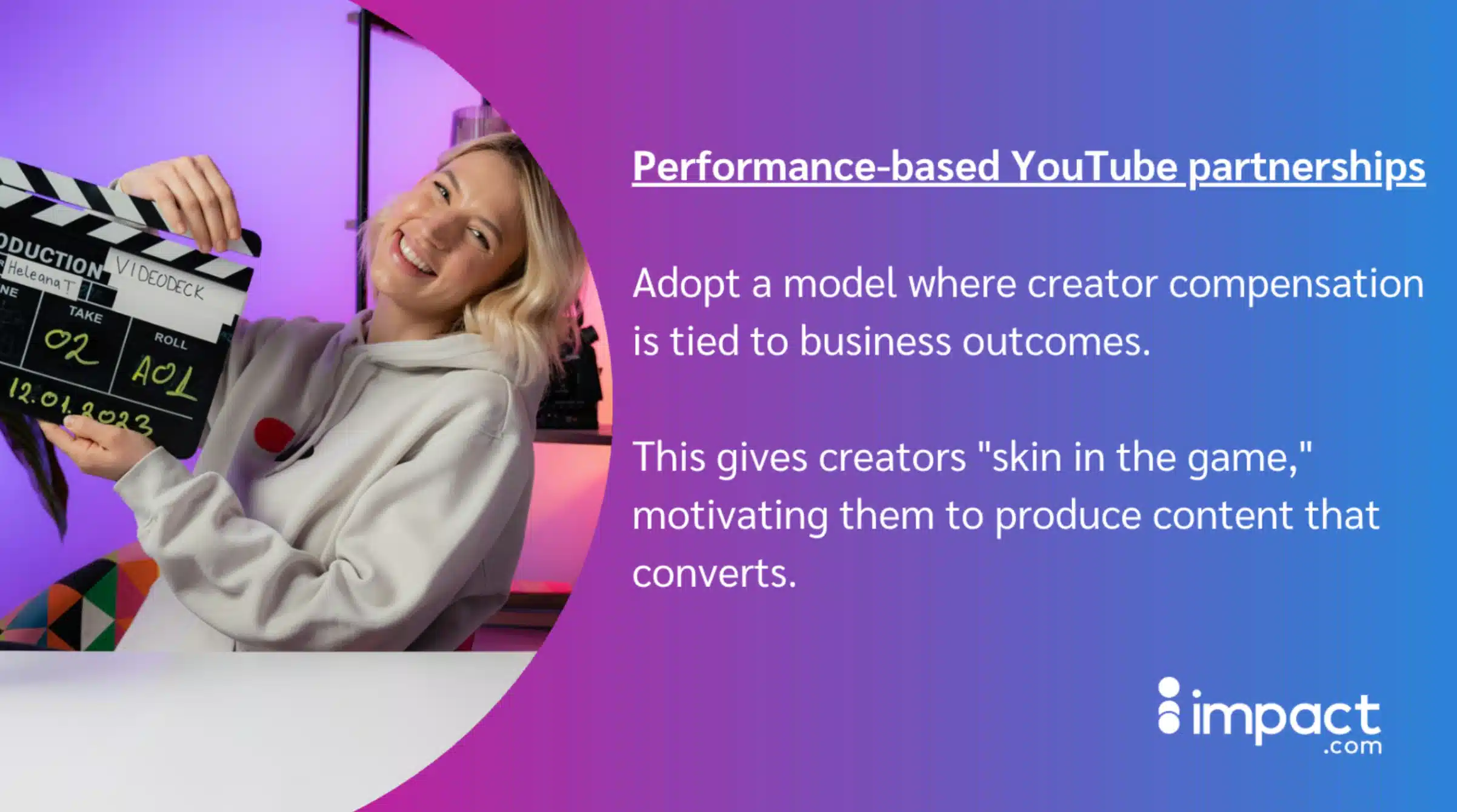
Three pillars your brand needs for a high-performing YouTube influencer strategy
- Audience-first discovery
- Performance-based compensation
- Integrate social commerce into your content
These three pillars form the foundation of a successful YouTube influencer program.
Miss one, and your strategy will underperform. Master all three, and you’ll build a scalable engine for growth.

Pillar 1: Audience-first discovery
Problem: You may struggle to pinpoint your target audience without the right tools. You might start with creator discovery—browsing through channels, checking follower counts, and making gut-level decisions about who to partner with. This approach is backward.
Solution: Start with a crystal-clear understanding of your target customer. Only then can you identify creators whose audiences match that profile.
Define your target persona
Go beyond basic demographics. Knowing your target customer is “women 25-45” isn’t enough. You need to understand:
- What content do they consume?
- Are they watching quick reviews or in-depth tutorials?
- What problems are they trying to solve?
- At what stage of the buying journey do they turn to YouTube?
Create a detailed profile of their online behavior. This deeper understanding enables you to identify creators who can authentically connect with your target audience.
Leverage AI for partner discovery
Manual creator discovery is time-consuming and often misses perfect-fit creators.
Actionable steps: Use a partnership management platform like impact.com with AI-powered discovery tools to streamline your search.
- AI-powered suggestions pull up instant matches aligned with your target audience.
- These tools analyze audience demographics, engagement patterns, content themes, and historical performance.
- Features like creator profile slideouts provide deeper insights into engagement rates and authenticity to create your top partner shortlist.
Why follower count doesn’t matter
In 2026, views and follower count are often vanity metrics. The focus must shift to metrics that directly impact your bottom line: conversions, CAC, and CLV.
Creators with less than 75,000 followers represent the backbone of a scalable, profitable program. In many cases, a portfolio of 10 micro-influencers can outperform one mega-influencer at the same cost.
Why do nano- and micro-influencers work?
Nano- and micro-influencers consistently outperform larger creators on metrics that matter: engagement, trust, and conversion rates. Here are the key benefits:
1. High trust and engagement
These creators have a personal and authentic relationship with their followers, actively engaging with them.
Tyler Denk, Co-Founder and CEO of beehiiv, has seen it firsthand: A creator with 50,000 loyal viewers will “outperform a million-subscriber channel” that rarely engages.
Here’s why: When an audience genuinely trusts their recommendations, they are far more likely to try featured products.
2. Precision and niche targeting
Micro-influencers excel in niche markets, serving as a go-to resource for specific passions.
This specialization means you work with a creator whose entire audience matches your ideal customer profile.
For B2B or technical fields, authenticity is credibility. They are subject matter experts whose technically accurate content creates immediate trust.
3. Cost-effectiveness and high ROI
These tiers are the most budget-friendly option, allowing you to work with multiple creators for the cost of one mega-influencer.
Alex Meyerhans, CEO of Get Me Links, shares that a micro-influencer’s content for a luxury home brand drove a 47 percent increase in referral traffic and doubled the site’s organic conversions within 90 days, outperforming bigger names who charged 10x more.
This proves that follower count doesn’t equal influence when driving business results.
4 tips for collaborating with nano- and micro-influencers
1. Look for creators whose values align with your brand’s ethos
Authentic partnerships start with genuine alignment. If a creator isn’t passionate about your brand, their audience will sense it.
2. Vet creators to get a feel for if they’d be the right fit
Do they post regularly and engage with their audiences? Consistency matters.
A creator who posts sporadically or rarely responds to comments may have high follower counts but low engagement.
3. Provide clear briefs and expectations from the beginning
Clarity prevents misunderstandings and disappointing results.
List clear markers for your partners:
- Specific goals and targets
- Key messages and deliverables
- Brand guidelines and parameters
4. Give them creative freedom
Caspar Matthews, Director of Electcomm Group Electrical & Data says he provides technical facts and footage and lets the creator handle the rest.
After all, they know their audiences best. They’ve built their following by creating content their audience loves. Trust them to maintain that voice and style while seamlessly integrating your product.

The influencer portfolio approach: How to implement all creator tiers
While your brand benefits from the authenticity and high conversion rates of nano- and micro-influencers, a complete strategy requires a balanced influencer portfolio.
The most sophisticated programs don’t choose one tier; they strategically deploy all of them for maximum ROI. This approach ensures you reach consumers at every stage in their buyer’s journey.
| Influencer tier | Primary campaign objective | Key benefit |
| Micro/Nano | Conversion, niche market penetration | High trust and engagement (seen as a peer) |
| Macro/Celebrity | Brand awareness, product launches | Instant mass reach and aspirational positioning (signal of prestige) |
To launch major products or enter new markets, you need the scale of macro-influencers and celebrities to achieve broad visibility. By adopting a tiered strategy, you mitigate risk and align the right creator size with the right business goal.
Pillar 2: Performance-based compensation
Problem: Negotiating with creators on a flat-fee basis creates risk and limits the creator’s earning potential.
Here’s why: When you pay a flat fee, you’re betting that the content will perform well—but you have no recourse if it doesn’t. Meanwhile, the creator has no incentive to go above and beyond, since their payment is fixed regardless of outcomes.
Solution: Shift the conversation from “What’s your rate?” to “What can we build together?” This reframing transforms the relationship from transactional to collaborative.
“AI makes it easier now than ever to analyze impact and predict ROI, but strategy doesn’t go away,” says Michael Alexander, Managing Director of Tangible Digital. The real power is in aligning your brand goals with the creator’s natural storytelling ability.
Give your partners creative control to foster long-term partnerships
Give creators a long enough runway and the creative control they need to do their best work. Short-term, one-off campaigns don’t give creators time to understand your brand or develop content strategies that resonate with their audience.
Think in terms of series, not single videos, Denk advises. YouTube algorithms reward consistency and a series of videos builds consumer trust. A creator who features your brand three times over three months will convert better than a one-off shoutout every time.
Here’s what happens when a creator features your brand multiple times:
- First time: Audience notices.
- Second time: Audience starts to believe the creator genuinely uses it.
- Third time: Audience is ready to try it themselves.
Long-term partners learn more about your brand, becoming true advocates. This enables them to create more effective, authentic content. Especially when they’re not reading from a brief, but rather sharing genuine experiences.

Performance-based compensation
Implement a base fee plus a commission structure that aligns creator success directly with yours. This creates a win-win situation for both parties.
Creators know they’ll be compensated fairly for their time regardless of outcomes, but they also have unlimited earning potential if they create content that truly resonates and drives sales.
Meanwhile, you’re protected from investing thousands in content that doesn’t perform.
Contractual clarity
Your agreement must clearly define the deliverables, compensation structure, and the usage rights to repurpose the content (for example, for paid ads). Ambiguity eliminates disappointment. Be specific about what you’re expecting and what the creator can expect from you.
Include details like:
- The number of videos included in the campaign
- Delivery timelines
- How performance will be measured
- Commission payout timelines
- Outlining approval processes
Securing long-term content repurposing rights
A key element of the contract is defining your brand’s right to repurpose the creator’s content.
Since long-form videos are treated as evergreen assets, securing the rights to use snippets in paid ads, on your brand’s social channels, and in other marketing materials maximizes long-term ROI.
Usage rights transform the content from a one-time video into a long-term, high-performing media asset. Ensure the agreement specifies the usage duration (e.g., perpetual vs. 12 months) and whether additional payment is required for repurposing (such as paid media usage).
A comprehensive contract protects both parties and sets the foundation for a positive partnership. Don’t skip this step or rush through it.
How much are YouTube influencers paid? [A three-part compensation model]
Structure your compensation across three tiers to balance guaranteed payment with performance incentives:
| Tier | Description | Payment trigger | Example goal |
| 1. Base fee (guaranteed) | Covers production costs and time. | Paid upon delivery of content. | $1,000+ for one long-form video, depending on follower size. |
| 2. Commission (performance) | Percentage of revenue. | Paid on sales/conversions attributed via affiliate link/promo code. | 10 percent commission on all sales. |
| 3. Bonus tier (incentive) | High-value incentive for exceptional results. | Paid upon reaching a specific key performance indicator (KPI) milestone. | $1,500 bonus for reaching 5x ROAS or 500 sales. |
This structure ensures creators are compensated fairly for their work while incentivizing them to create content that drives measurable business results. The base fee covers costs, the commission rewards performance, and the bonus tier motivates exceptional effort.
Performance-based partnerships
As your marketing budgets come under increasing scrutiny, the need to measure results and justify ad spend becomes critical. This reality is driving a shift toward performance-driven partnerships where compensation is directly tied to outcomes.
Instead of flat fees, consider using hybrid or performance-based compensation models that incorporate commissions, affiliate links, or bonuses for achieving specific targets.
This approach has dual benefits:
- Your brand only pays partner premiums when its tied to exceptional performance
- Creators have unlimited earning potential if they deliver strong results
Jason Rowe, Director and Founder of Hello Electrical, found success with this model: “The initial collaboration achieved 28 percent growth in leads to the websites in six weeks, and the cost per lead (CPL) dropped to $30 compared to $42.”
Pillar 3: Integrate social commerce into your content
If your content is perceived as too promotional, viewers may tune out, which can limit your campaign’s impact and ROI.
Vladimir Lebedenko, Head of Marketing at HostZealot, advises treating creators as educators, not advertisers. People come to YouTube to learn, solve problems, and be entertained.
Prioritize a series of shoppable and educational videos
Use YouTube’s product tagging features to integrate your products into valuable tutorial or educational content.
Dr. Kevin Huffman, CEO and Founder of Ambari Nutrition, recruited influencers to create shoppable educational content through long-form videos for bariatric and diabetic patients.
Video topics included:
- “How can I manage sugar cravings post-surgery?”
- “Making a diabetic-friendly meal plan”
Ambari’s products are featured as solutions and tagged directly in the videos, making the promotion feel natural and helpful.
Results
- Revenue up 300 percent
- Conversion rates 40 percent higher than average
Psychology behind the success: When someone is actively learning how to manage sugar cravings and a trusted creator demonstrates a specific product that helps, that recommendation becomes a lightbulb moment. The viewer is already problem-aware and solution-seeking. Now you’ve given them a solution.
Grant creators autonomy to ensure authenticity
Provide non-negotiable technical facts and product footage, but allow the creator to use their authentic voice and storytelling rhythm to build trust. Matthews notes that giving this freedom “will always result in more authentic storytelling and involvement.”
But creators know their audiences best including:
- What tone resonates best
- Top-performing formats
- How to integrate sponsored content without losing credibility
Your brand’s job is to provide the raw materials they need: Accurate product information, high-quality footage or samples, and clear goals to hit. The creator’s job is to package that information in a way their audience will actually engage with.
The results speak for themselves: Allowing creative freedom can significantly impact conversion rates. Matthews saw conversion rates hit 18 percent. This was almost three times the rate he got compared to other social platforms.

Implementation tool: Use YouTube Shopping to blend affiliate marketing with social commerce
The growth of affiliate marketing is tied to the rise of social commerce, which has blurred the line between social media and shopping.
On YouTube, this relationship creates a powerful conversion engine. YouTube’s Partner Program streamlines commissions and product samples for creators, making it easier than ever to set up and manage affiliate partnerships.
But the real game-changer is YouTube’s expanded e-commerce feature: YouTube Shopping. Creators can tag products in videos and use shopping shelves to drive sales directly from their content—including branded merch. This creates a frictionless path from “I’m interested” to “I’m buying.”
Tutorial-type content performs 5x better than promotional videos, according to Baris Zeren, CEO of Bookyourdata.
Implementation tip: Give creators unique promo codes or affiliate links to track conversions and compensate them fairly.
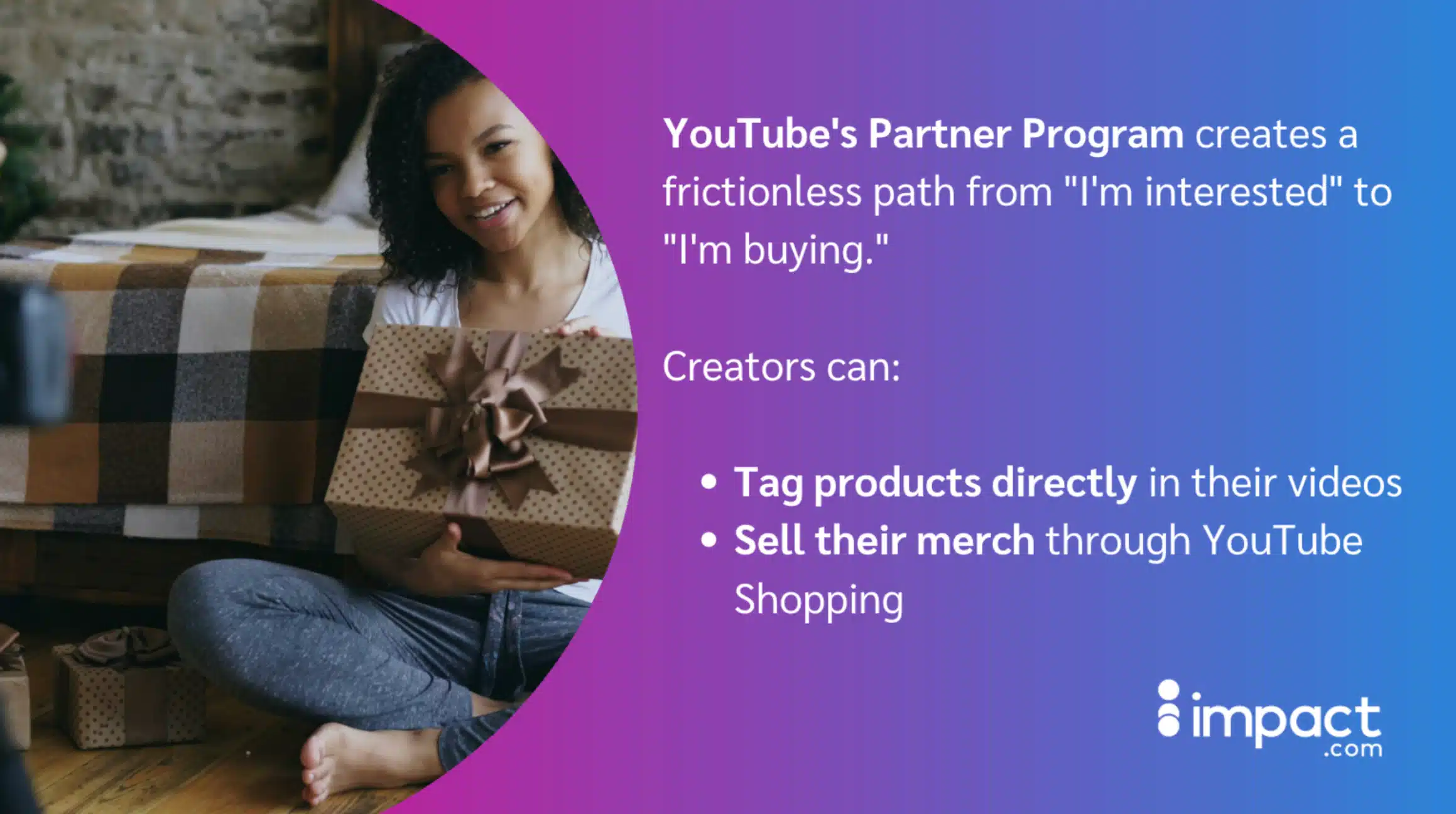
Why is YouTube’s long-form content a key advantage?
Content duration is where YouTube fundamentally differs from its competitors. While TikTok and Instagram Reels excel at capturing attention, YouTube’s long-form format enables creators to demonstrate value in ways that short clips can’t replicate.
In a single video you can:
- Show the full scope of your product’s benefits
- Walk through complex use cases
- Address common objections
Let’s discuss some of the other advantages YouTube has over other social platforms.
B2B and high-value sales
For B2B brands or companies selling high-ticket items, long-form content attracts higher-intent buyers.
- Serious buyers: A viewer who watches a 15-minute tutorial isn’t casually browsing; they are serious about solving their problem and actively evaluating solutions.
- Superior conversions: Long-form content netted Zeren’s YouTube campaigns three times higher conversion rates compared to short-form content.
Evergreen value
Treat every video as a long-term asset. Educational and tutorial-based content remains relevant and continues to appear in YouTube’s search results for months or even years.
- Compounding visibility: This bank of content creates compounding visibility, generating returns over time.
- Reduced cost per acquisition (CPA): The initial production cost is the same whether 1,000 or 100,000 people watch it, meaning your CPA drops dramatically over time.
- 24/7 salesperson: Every long-form video acts as a salesperson who works 24/7, demonstrating your product’s value to an endless stream of qualified prospects.
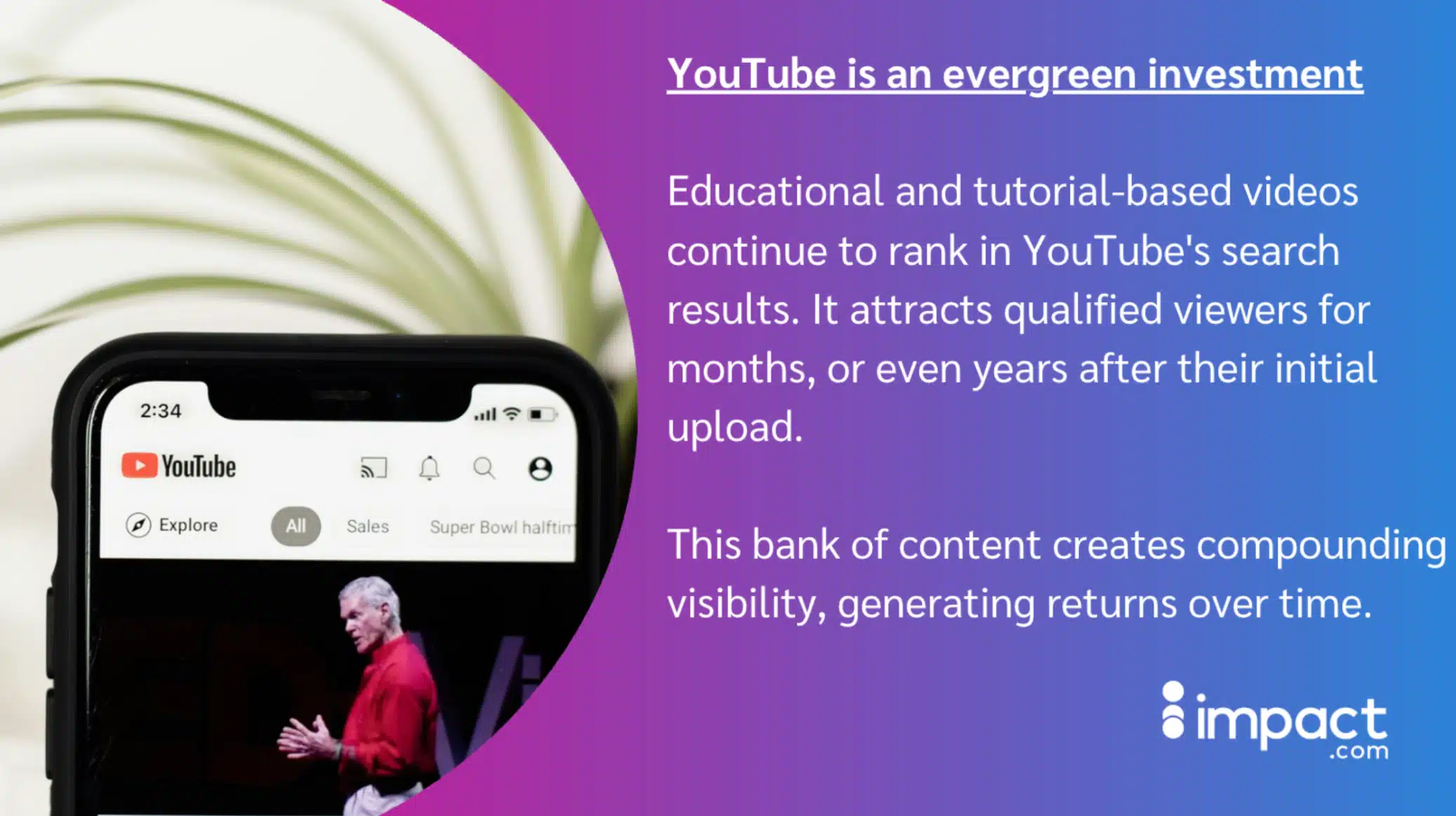
Deeper trust and connection
Viewers build an emotional connection with creators when they invest a lot of time watching their content. This happens when the creator genuinely demonstrates your product’s value, linking trust to your brand.
YouTube’s format is perfect for brands like Kenko Matcha, whose founder, Sam Speller, notes that audiences proactively seek out how to make wellness a ritual. By demonstrating how the product fits naturally into a health-conscious routine, Kenko Matcha’s content inspires wellness audiences to incorporate it into their lifestyles.
YouTube Shorts: Leveraging a second algorithm to target new audiences
Once you’ve mastered long-form content, YouTube Shorts can complement your strategy and reach diverse audiences.
What are YouTube Shorts? It is vertical videos under 60 seconds designed to capture attention quickly and drive discovery.
Why YouTube Shorts are an effective influencer marketing strategy: With 70 billion daily views, Shorts offer a powerful way to enhance your visibility and reach a wider, often younger audience who might not initially seek out your longer content.
YouTube has a dedicated Shorts page that makes your videos easier to discover, essentially giving you a second algorithm to leverage within the platform. This means you can reach audiences who primarily consume short-form content while still maintaining your long-form strategy for deeper engagement.
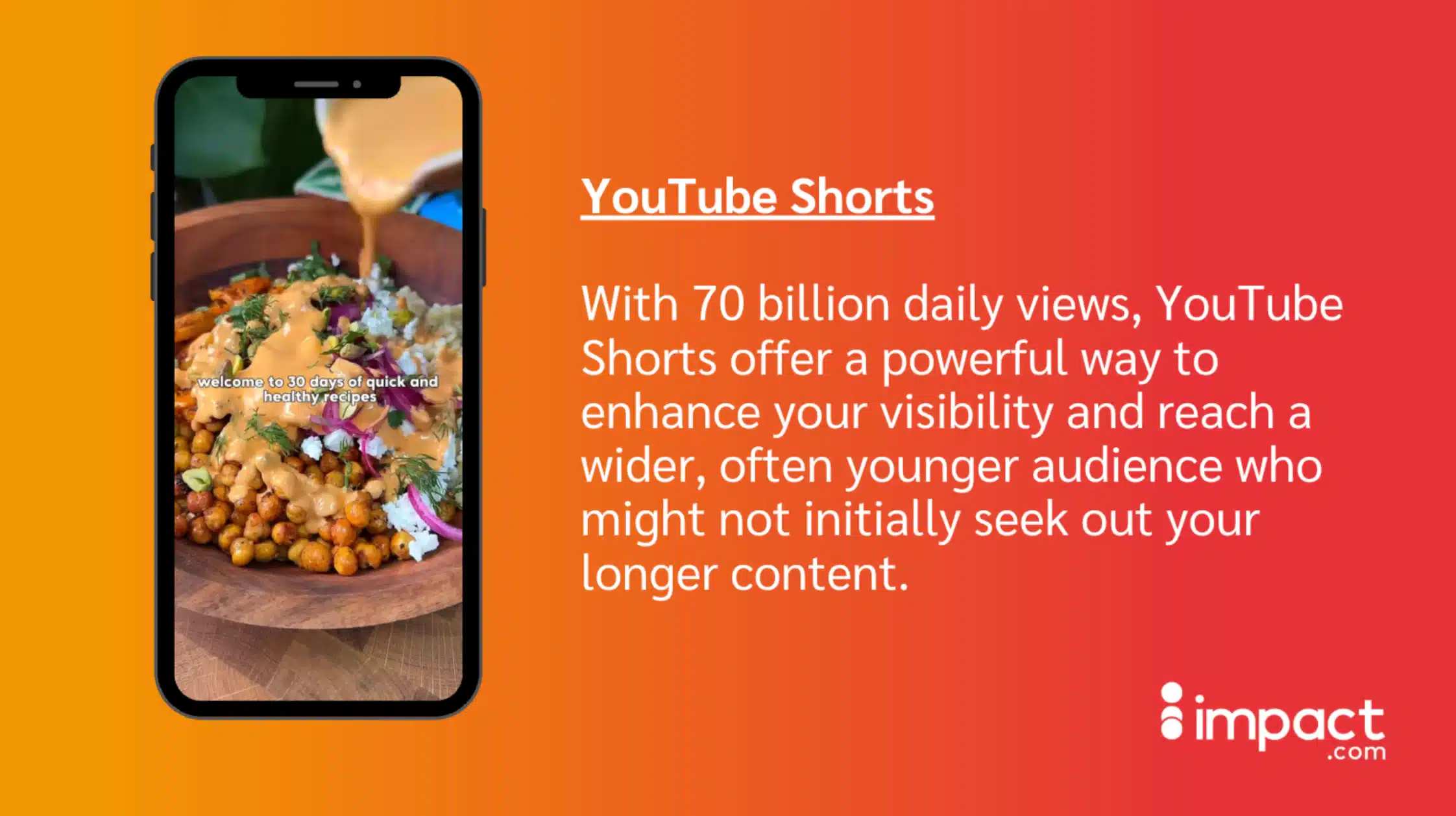
YouTube Short checklist
- Create quick, snackable content to drive brand awareness and virality.
- Showcase products in action with quick demos or behind-the-scenes content.
- Tell brief but compelling stories related to your brand’s journey or values to foster loyalty and trust.
- Share quick tips or tutorials that position your product as the solution while delivering actionable advice that viewers can use immediately.
Implementation tips
- Hook viewers within the first 3 seconds to maximize engagement.
- Add text overlays and captions, as many viewers watch Shorts without sound.
- Include a clear call-to-action (CTA), such as a link to your product page in the description.
| YouTube content types: A quick overview | |||
|---|---|---|---|
| Content format | Description | Best for | Examples |
| Product reviews/ unboxings | The creator gives an honest, in-depth look at your product, demonstrating its features and benefits. | Product launches, building trust. | On the Sleepopolis channel, creator Kendall provides an in-depth review of the Nectar Premier mattress, a brand owned by Resident. While building trust with viewers, the review also includes a 50 percent off coupon to encourage sales. |
| Tutorials/how-tos | The creator shows how to use your product to solve a specific problem or achieve a goal. | Driving sales, educating customers. | In this 25-minute video, Creator Jona Shone blends a review of B&Q’s tools with a tutorial on building a tool wall display. |
| YouTube Shorts | Short, vertical videos (under 60 seconds) for quick, snackable content. | Brand awareness, reaching a new audience, virality. | Prebiotic soda brand OLIPOP reposts a 15-second YouTube Short from a creator. The video quickly highlights the product and its health benefits, making it an easily shareable, informative piece that generates brand awareness. |
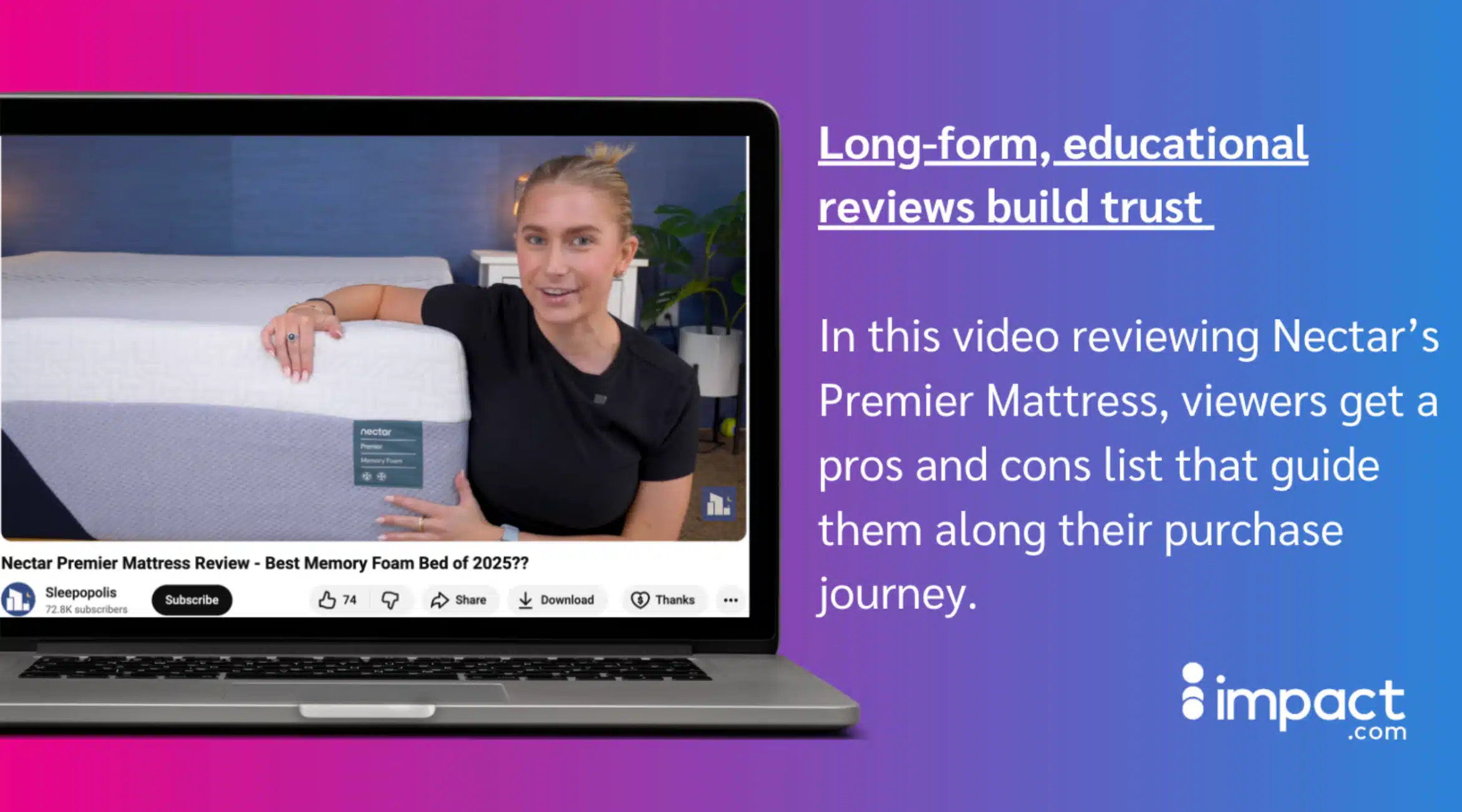
Case study: GetSmarter’s winning YouTube strategy
Online education provider GetSmarter wanted to boost brand awareness and increase course sign-ups for its University of Cape Town offerings. The team partnered with impact.com to move from a traditional approach to a data-driven, strategic one.
How GetSmarter used the three-pillar framework
Pillar 1: Audience-first discovery
GetSmarter recruited 16 influencers from diverse niches, including students and entrepreneurs. Instead of casting a wide net with generic messaging, this targeted approach allowed them to create inspiring, authentic content that resonated more closely with their target audience.
Pillar 2: Performance-based compensation
The team implemented a hybrid payment model that included base fees and performance incentives. They tracked conversions and ROI using unique promo codes and custom links that delivered precise attribution for each creator’s contribution.
Pillar 3: Social commerce integration
Influencers created educational content and were given creative freedom to naturally integrate the courses into their videos. They included a 20 percent-off promo code in the content and used custom links in descriptions to take viewers directly to the sign-up page.
Impressive results
- 8 million impressions
- 1.5 million+ reach
- 620k clicks
- Low cost per click (CPC) of $0.01 for content amplification
- 78 pieces of user-generated content (UGC)
By implementing this strategic, three-pillar model, GetSmarter exceeded campaign goals and reached new milestones. This proves that a structured, performance-driven approach delivers measurable results.

The measurement and optimization framework
Problem: Without a robust attribution system, you can’t connect a video view to a new customer. This is the gap that kills most influencer programs: you can see engagement metrics, but you can’t prove ROI to your CFO.
Solution: Pair a comprehensive measurement framework with the right technology to track and analyze performance in real time. This approach separates experimental campaigns from scalable programs.
The creator partnership flywheel
- Track
- Analyze
- Optimize
- Scale
Track
Use unique affiliate links and promo codes for direct sales attribution.
Beyond direct attribution, use UTM parameters to track website traffic and user behavior from each creator’s video. This shows you not just who’s driving conversions, but who’s driving valuable traffic to visitors who:
- Browse multiple pages
- Spend significant time on the site
- Add items to their cart (even if they don’t purchase immediately)
You can also track website visits from devices that viewed the content using attribution and measure search activity for a featured offer within 48 hours. This captures some of the soft conversions. These are people who see the video but don’t click through immediately, then search for your brand or product later.
Analyze
Focus on conversions, customer acquisition cost (CAC), and ROAS.
Tracking the impact on customer acquisition is key: Traffic from Huffman’s collaboration converted 40 percent higher than their program’s average traffic. With this kind of data in hand, you can identify which creators are actually driving valuable customers, not just views.
Look for patterns in the data:
- Do certain content formats consistently outperform others?
- Do specific product categories convert better through influencer content?
- Are there certain audience demographics that show higher lifetime value?
This analysis informs your optimization strategy.
Optimize
Use the data to refine your strategy continuously. Which creators drive the most value? What type of content converts best? The answers to these questions should directly inform how you allocate budget and structure future partnerships.
Rowe’s team discovered that, compared to highlight reels, shooting jobs that showcased their businesses’ full service enhanced viewers’ retention beyond 60 percent and generated greater conversion intent, based on comments and direct inquiries. This insight enabled them to provide more effective creative direction to future creator partners.
To see best results, treat optimization as an ongoing process:
- Test new approaches
- Measure results
- Double down on successful strategies
- Cut underperforming startegies
Scale
Reinvest your budget into the most successful partnerships. Once you’ve identified creators who consistently drive strong ROAS, increase your investment with them. Offer them longer-term contracts, higher base fees, or better commission structures to secure their ongoing partnership.
Simultaneously, use the insights you’ve gained about what makes partnerships successful to recruit similar creators. If a micro-influencer in the sustainable fashion niche is crushing it for your eco-friendly apparel brand, find five more creators with similar audience profiles and content styles.
Multi-platform strategy: Integration with TikTok and Instagram Reels
A successful 2026 influencer marketing strategy spans multiple platforms, maximizing reach and engagement. But understanding where YouTube fits in this broader strategy is essential because each platform serves different purposes.
Viewer intention across platforms
- Instagram: Visual discovery
- TikTok: Viral trends
- YouTube: Intentional platform for depth and education
Content strategy by platform
- TikTok and Instagram Reels (short-form): Drive virality and awareness. Catch attention while scrolling.
- YouTube (long-form): Build trust, depth, and conversions. Targets audiences actively seeking information.
The funnel analogy
- TikTok/Instagram Reels: Introduce the brand, pique interest.
- YouTube (Shorts and long-form): Educates viewers about the product, convince them to buy.
Brand tips for cross-posting on YouTube
Goal: Maintain a cohesive and professional brand image across all platforms.
Action: Ensure all cross-posted videos are re-edited or lightly optimized for the YouTube environment.
Optimization examples:
- Add platform-native elements.
- Adjust the aspect ratio if needed.
- Incorporate branded end screens or calls-to-action (CTAs).
- Ensure CTAs link only to your other official brand channels.
The benefits:
- Avoids algorithm penalties.
- Ensures every piece of content reinforces your brand’s presence.
- Maximizes the opportunity to convert viewers into customers, regardless of where they first encountered the video.
Compliance: Updated FTC guidelines and disclosure requirements
- Prominent placement
- Clear language
- Material connection
The Federal Trade Commission (FTC) has updated its guidelines to make “clear and conspicuous” disclosures a legal requirement, not a suggestion. Non-compliance can result in significant fines for your brand and creator partners.
These regulations apply to all content formats, including YouTube videos, Shorts, and livestreams.
Key requirements
Prominent placement
Disclosures must be clearly visible and audible. For video content, a verbal disclosure should happen within the first 5 seconds, and a text overlay should appear within the first 3 seconds, remaining visible throughout the video.
Clear language
Use unambiguous terms like “Paid Partnership” or “Ad.” Avoid vague terms like “#partner” or “collab,” which might confuse viewers about the nature of the relationship.
Material connection
Disclosure is required whenever there is a material connection to a brand, even if your brand doesn’t ask for a mention or the influencer only received free product. Make sure your creator partners understand this requirement.
FAQs
Go beyond manual searches. The most efficient way is to use an AI-powered discovery tool that analyzes an influencer’s audience demographics, content themes, and historical performance to ensure a perfect match with your brand’s target customer. These tools save time and help you avoid costly mismatches.
A performance-based model, which uses commission and bonuses, directly ties a creator’s earnings to the results they generate (such as sales or sign-ups). This incentivizes them to create higher-quality, more authentic content that converts, and it provides your brand with clear, measurable ROI. You only pay premium compensation when you see premium results.
Use a combination of tools. Implement unique affiliate links and promo codes for direct sales attribution. Use UTM parameters to track website traffic and user behavior from each creator’s video. A centralized partnership management platform is essential for consolidating this data and calculating true ROI across all your creator partnerships.
Use YouTube Shorts for brand awareness and top-of-funnel reach. Partner with creators to produce short, viral-style content that introduces your brand to a new audience. Then, drive that audience to longer-form videos that offer in-depth product information and a clear call to action. This creates a complete funnel from discovery to conversion.
A strong agreement should clearly outline deliverables (such as one long-form video and two Shorts), the compensation structure (for example, base fee plus commission), and content usage rights (your ability to repurpose their content for paid media). This ensures transparency and protects both parties from misunderstandings.
The future of YouTube influencer marketing: Operational sophistication and scalable ROI
The brands thriving on YouTube in 2026 aren’t the ones with the biggest budgets—they’re the ones with the smartest strategies. They’ve moved beyond treating influencers as temporary media buys and embraced a performance-based partnership model that aligns incentives and drives measurable ROI.
The best results come when brands treat creators as collaborators, not ad space. When both parties have a vested interest, you create incentives for creators to go above and beyond.
The transformation to a scalable program:
The real transformation happens when you shift your focus from single campaigns to a scalable, predictable program. This involves executing the three pillars:
- Audience-first discovery: Building a portfolio of creator partnerships for consistent and predictable results.
- Performance alignment: Continuously measuring, optimizing, and scaling your most successful partnerships.
- Value-centric content: Treating each video as a long-term digital asset that continues to drive value.
Your new focus:
Don’t leave money on the table with flat fees and transactional content. Operational sophistication is the new competitive advantage, and the data proves that a structured, performance-driven approach delivers measurable results.
Check out more content here:
- impact.com partners with YouTube to increase revenue for brands and creators with affiliate marketing [blog]
- State of Affiliate Marketing 2025 [research report]
- The limitations of AI influencer marketing: What brands need to know in 2025 [blog]
- The Partnership Economy Podcast: Product-Led Advocacy with Ashley Stead
- Marketing budget optimization: The performance marketer’s guide to partnership-driven growth [blog]
- How Creators Drive $46 Billion in Southeast Asia E-commerce | impact.com Creator Insights 2025
